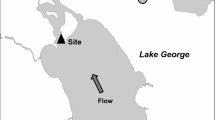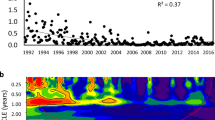Abstract
Weekly studies of phytoplankton biomass and environmental variables were made over one year in a shallow stratifying, hypertrophic El Porcal lake near Madrid (Spain). Data were collected on abiotic factors, primary production, biomass and phytoplankton losses and subjected to reduction by means of several principal component analyses. Furthermore, weekly data on the same variables were gathered from published studies on Überlinger See, an embayment of the much deeper, mesotrophic Lake Constance (Central Europe), and treated in the same way. The two first principal components of PCAs on biological variables explained more than 60% of overall variance in both lakes. They could be ascribed to phytoplankton production + biomass and photosynthetic physiology + phytoplankton losses, respectively. The ordination of the biological trajectories in the data space of the two first principal components revealed six stable states of phytoplankton biomass in the shallow lake and seven in the deep lake. The breakpoints between stable states could be due to environmental, abiotic variables in some cases but biological interactions were suspected to be the cause of the other breakpoints. The abiotic effects on phytoplankton biomass took longer to occur in the deep lake. Also, short-term dynamics (one-three weeks) were demonstrated for both phytoplankton communities.
A preliminary comparison between phytoplankton biomass dynamics in stratifying, shallow and deep lakes suggests that differences may be attributed partly to differences in depth.
Similar content being viewed by others
References
Allen, T. F. H., 1971. Multivariate approaches to the ecology of algae on terrestrial rock surfaces in North Wales. J. Ecol. 59: 803–826.
Allen, T. F. H. & J. F. Koonce, 1973. Multivariate approaches to algal stratagems and tactics in systems analysis of phytoplankton. Ecology 54: 1234–1246.
Allen, T. F. H., S. M. Bartell & J. F. Koonce, 1977. Multiple stable configurations in ordination of phytoplankton community change rates. Ecology 58: 1076–1084.
Allen, T. F. H., D. A. Sadowsky & N. Woodhead, 1984. Data transformation as a scaling operation in ordination of plankton. Vegetatio 56: 147–160.
Allen, T. F. H. & T. B. Starr, 1982. Hierarchy. Perspectives for ecological complexity. Univ. Chicago Press, Chicago, 310 pp.
Alvarez Cobelas, M., 1991. Optical limnology of a hypertrophic gravel-pit lake. Int. Revue ges. Hydrobiol. 76: 213–223.
Alvarez Cobelas, M., 1992. Temperature and heat in a hypertrophic, gravel-pit lake. Arch. Hydrobiol. 125: 279–294.
Alvarez Cobelas, M., A. Rubio, M. Araúzo, P. Alarcón & V. Alario, 1987. Morfometría y composición química de una laguna de gravera. Limnetica 3: 91–95.
Alvarez Cobelas, M., A. Rubio & J. L. Velasco, 1990. Chemical limnology of a hypertrophic gravel-pit lake. Ann. Limnol. 26: 97–108.
Alvarez Cobelas, M., F. J. Haering, J. L. Velasco & A. Rubio, 1992. The seasonal productivity of phytoplankton in a hypertrophic, gravel-pit lake. J. Plankton Res. 14: 979–996.
Chatfield, C., 1984. The Analysis of Time Series. An Introduction. Chapman & Hall, London, 286 pp.
Dixon, W. J., M. B. Brown, L. Engelman, J. W. Franc, M. A. Hill, R. I. Jennrich & J. D. Toporek, 1983. BMDP Statistical Software. 1983. Printing with Additions. Univ. California Press, Berkeley, 734 pp.
Elster, H. J., 1977: Der Bodensee. Bedrohung und Sanierungsmöglichkeiten eines Ökosystems. Naturwissenschaften 64: 207–215.
Forsberg, B. R., 1985. The fate of planktonic primary production. Limnol. Oceanogr. 30: 807–819.
Gauch, H. G., Jr., 1982. Multivariate Analysis in Community Ecology. Cambridge University Press, Cambridge, 298 pp.
Gilpin, M. E. & T. J. Case, 1976. Multiple domains of attraction in competition communities. Nature 261: 40–42.
Harris, G. P., 1980. Spatial and temporal scales in phytoplankton ecology. Mechanisms, methods, models and management. Can. J. Fish. aquat. Sci. 37: 87–900.
Harris, G. P. & A. M. Trimbee, 1986. Phytoplankton population dynamics of a small reservoir: physical/biological coupling and the time scales of community change. J. Plankton Res. 8: 1011–1025.
Ibanez, F., 1981. Immediate detection of heterogeneities in continuous multivariate, oceanographic recordings. Application to time series analysis of changes in the bay of Villefranche sur Mer. Limnol. Oceanogr. 26: 336–349.
Jassby, A. D. & T. M. Powell, 1990. Detecting changes in ecological time series. Ecology 71: 2044–2052.
Kiefer, F., 1972: Naturkunde des Bodensees. Zweite Ed. Jan Thorbecke Verlag, Sigmaringen, 209 pp.
Levandowsky, M., 1972. An ordination of phytoplankton populations in ponds of varying salinity and temperature. Ecology 53: 398–408.
Legendre, L. & P. Legendre, 1979. Ecologie Numérique, 2. Masson et cie, Paris, 253 pp.
Margalef, R. & F. González Bernáldez, 1969. Grupos de especies asociadas en el fitoplancton del Mar Caribe, NE de Venezuela. Inv. Pesq. 33: 287–302.
Matthews, R. A., G. B. Matthews & W. J. Ehinger, 1991. Classification and ordination of limnological data: a comparison of analytical tools. Ecol. Modell. 53: 167–187.
May, R. M., 1977: Thresholds and breakpoints in ecosystems with a multiplicity of stable states. Nature 29: 471–477.
Mayzaud, P., S. Taguchi & P. Laval, 1984. Seasonal patterns of seston characteristics in Bedford Basin, Nova Scotia, relative to zooplankton feeding: a multivariate approach. Limnol. Oceanogr. 29: 745–762.
OECD, 1982. Eutrophication of Waters. Monitoring, Assessment and Control. OECD, Paris, 154 pp.
Oláh, J., 1975. Metalimnion function in shallow lakes. Symp. Biol. Hung. 15: 149–155.
Preisendorfer, R. W., 1988. Principal Component Analysis in Meteorology and Oceanography. Elsevier, Amsterdam, 425 pp.
Prevosti, A., 1974. La distancia genética entre poblaciones. Miscel. Alcobé, January: 109–118.
Reynolds, C. S., 1987. Community organization in the freshwater plankton. In J. H. R. Gee & P. S. Giller (eds), Organization of Communities, Past and Present. Blackwell Sci. Publ., Oxford: 297–325.
Reynolds, C. S., 1992. Dynamics, selection and composition of phytoplankton in relation to vertical structure in lakes. Arch. Hydrobiol. Beih. Ergebn. Limnol. 35: 13–31.
Rohlf, F. J., 1992. NTSYS-pc. Numerical Taxonomy and Multivariate Analysis System. Version 1.70. Exeter Software. Setauket, New York.
Rojo, C., 1990. Estructura de la Comunidad Fitoplanctónica de la Laguna Hipertrógica ‘El Porcal’ (Madrid). Ph. D. thesis. Univ. Literaria, Valencia, 389 pp.
Rojo, C. & M. Alvarez Cobelas, 1991. Phytoplankton assemblages of a hypertrophic, gravel-pit lake. Verh. int. Ver. Limnol. 24: 1550–1555.
Rojo, C. & M. Alvarez Cobelas, 1993. Hypertrophic phytoplankton and the intermediate disturbance hypothesis. 249/Dev. Hydrobiol. 81: 43–57.
Seip, N. L. & L. G. Snipen, 1993. Interaction between phytoplankton and zooplankton in lakes. Verh. int. Ver. Limnol. 25: 474–477.
Sephton, D. H. & G. P. Harris, 1984. Physical variability and phytoplankton communities: VI. Day to day changes in primary productivity and species abundance. Arch. Hydrobiol. 102: 155–175.
Sheffer, M., 1990. Multiplicity of stable states in freshwater systems. Hydrobiologia 200–201/Dev. Hydrobiol. 61: 475–486.
Sokal, R. R. & C. D. Michener, 1958. A statistical method for evaluating systematic relationships. Univ. Kansas Sci. Bull. 22: 1409–1438.
Sommer, U., 1987. Factors controlling the seasonal variation in phytoplankton species composition. A case study for a deep, nutrient-rich lake. Prog. Phycol. Res. 5: 123–178.
Sommer, U., Z. M. Gliwicz, W. Lampert & A. Duncan, 1986. The PEG*-model of seasonal succession of planktonic events in fresh waters. Arch. Hydrobiol. 106: 433–471.
Stabel, H. H., 1985. Mechanisms controlling the sedimentation sequence of various elements in prealpine lakes. In W. Stumm (ed.), Chemical Processes in Lakes. J. Wiley, New York: 143–167.
Steele, J. H. (ed.), 1978. Spatial Patterns in Plankton Communities. Plenum Press, New York, 470 pp.
Sterner, R. W., 1989. The role of grazers in phytoplankton succession. In U. Sommer (ed.), Plankton Ecology, Succession in Plankton Communities. Springer Verlag, Berlin: 107–170.
STSC, 1991. Statgraphics. Version 5. Rockville, Maryland.
Tilzer, M. M., 1984. Estimation of phytoplankton loss rates from daily photosynthetic rates and observed biomass changes in Lake Constance. J. Plankton Res. 6: 309–324.
Tilzer, M. M., 1990. Specific properties of large lakes. In M. M. Tilzer & C. Serruya (eds), Large Lakes, Ecological Structure and Function. Springer Verlag, Berlin: 39–44.
Tilzer, M. M. & B. Beese, 1988. The seasonal productivity cycle of phytoplankton and controlling factors in Lake Constance. Schweiz. Z. Hydrol. 50: 1–39.
van Tongeren, O. F. R., L. van Liere, R. D. Gulati, G. Postema & P. J. Boesewinkel-De Bruyn, 1992. Multivariate analysis of the plankton communities in the Loosdrecht lakes: relationship with the chemical and physical environment. Hydrobiologia 233/Dev. Hydrobiol. 74: 105–117.
Uhlmann, D., 1980. Stability and multiple steady states of hypereutrophic ecosystems. In J. Barica & L. Mur (eds), Hypertrophic Ecosystems. Development in Hydrobiology 2. Dr W. Junk Publishers, The Hague: 235–247.
Author information
Authors and Affiliations
Rights and permissions
About this article
Cite this article
Alvarez Cobelas, M., Velasco, J.L., Rubio, A. et al. The time course of phytoplankton biomass and related limnological factors in shallow and deep lakes: a multivariate approach. Hydrobiologia 275, 139–151 (1994). https://doi.org/10.1007/BF00026706
Issue Date:
DOI: https://doi.org/10.1007/BF00026706




